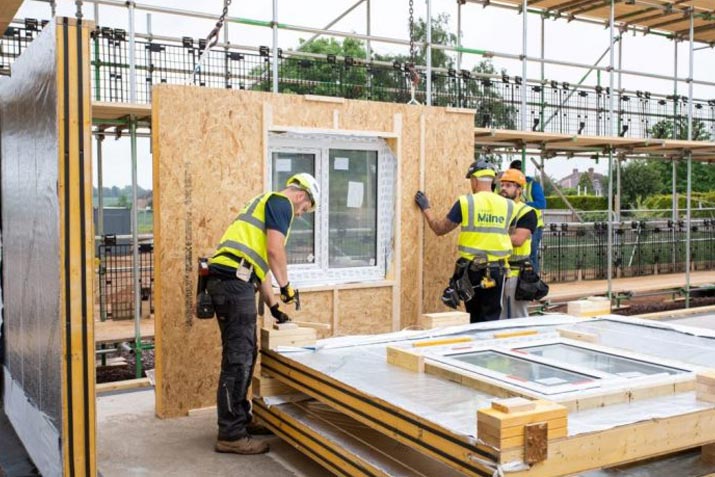

Study confirms utilising panelised MMC building systems correlates with fewer on-site accidents.
Commissioned by UK-based Stewart Milne Group for the Advanced Industrialised Methods for the Construction of Homes (AIMCH) research project, confirms that crane-lift panelised MMC building methods provide 20% less risk to health and safety than open-panel timber frame construction using a forklift.
The £6.5m AIMCH research project, seeks to industrialise housing production by making panelised MMC (modern methods of construction) mainstream.
MMC panelised systems are increasingly used to build houses that have progressively more manufactured components such as prefabricated floor cassettes, ready-fitted windows, and pre-insulated closed walls. These systems require a crane to offload and position the components on site.
The study, Health and Safety Risk Profiling of MMC Solutions, prepared by Stewart Milne Group, with support from Limberger Associates, assessed the difference in risk exposure between two timber frame systems: one built on site using manual assembly techniques with the aid of a forklift (GEN1), also typical of masonry-built homes; the other a more advanced system (GEN3), using higher levels of prefabrication, requiring the use of a crane on site.
Stewart Dalgarno, AIMCH project director and director of innovation & sustainability at Stewart Milne Group, said: “This is the first study we have undertaken to compare the health and safety risk exposure of both construction methods and it is gratifying to see that the crane-erect panelised MMC methods championed by AIMCH reduce safety risks and hazard exposure by 20% on site, where the injury rate per 100,000 workers is 42% higher than in manufacturing, and where 50% of deaths are attributed to falls from height, compared with 16% in manufacturing.”
The study evaluated working practices and techniques in two areas, floors, and windows, where increasing the pre-manufactured value (PMV) is becoming more common. The study developed a methodology for assessing risk, aligned with Health & Safety Executive (HSE) hazard classifications, and consequential risk profiles were developed for each. These covered hazards such as falls from height; slips and trips; moving and handling loads; and lifting operations and were used to compare the effect of on-site working practice differences between GEN1 site assembly and GEN3 prefabricated construction methods.
In both areas the use of GEN3 systems transfers some of the health and safety risks from the construction site to the factory, “where workplace safety systems are generally better managed,” it asserted.
In addition to the health and safety benefits, the study highlighted the following as benefits of using GEN3 crane-erect panelised MMC systems:
See: www.aimch.co.uk
CLICK HERE to return to the home page for more articles.